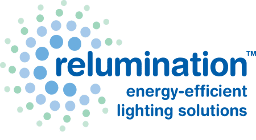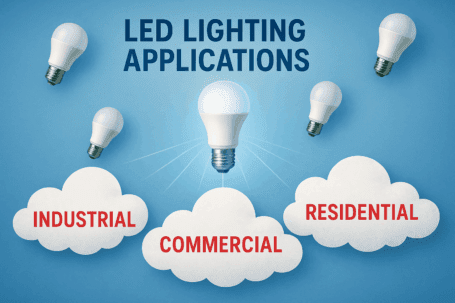
Done right, interior lighting can dramatically reduce operating costs, improve mood and productivity, enhance the look and value of a property, and create a memorable experience for customers, guests, and employees.
In this article, we’ll walk through the main interior lighting options (fluorescent, high-intensity discharge, and especially LEDs), how light impacts the brain and performance, how to layer ambient, task, and accent lighting, practical design tips for different types of spaces, and why partnering with Relumination for energy-efficient lighting systems is a smart long-term decision.
Why Interior Lighting Matters More Than You Think
Lighting systems are very important parts of any commercial or residential building. Because of this, you need to ensure that you properly use the quality lighting you choose for your home or work environment.
Quality interior lighting is essential because it allows you to see well and increases your property’s value. You can also improve the appearance of your building with the help of interior lighting.
Beyond simple visibility, interior lighting:
- Shapes first impressions – whether it’s a coffee shop, office, classroom, or clinic, lighting is a big part of the “feel” when someone walks in.
- Affects safety and accuracy – from kitchen prep to manufacturing lines to office work, poor light levels increase errors and can create hazards.
- Impacts health and mood – light influences sleep, circadian rhythm, and even brain structure and function.
- Drives operating costs – lighting is often one of the biggest factors in your electricity bill, making it a good idea to explore your options and the benefits of energy-efficient interior lighting.
If you are currently unhappy with your lighting, the good news is that you can easily upgrade your current lighting systems to ensure that you use quality lighting at all times. Interior lighting should be able to help you reduce the costs of energy while maximizing productivity and comfort.
Relumination specializes in exactly this: energy-efficient lighting installations, systems, and solutions that improve the quality of light and reduce long-term costs.
The Science: How Interior Lighting Affects the Brain, Mood, and Performance
We all intuitively know that good lighting makes a space feel better, but research shows it goes much deeper than that.
Dim vs. Bright Light and the Brain
Spending too many hours in workplaces with dim lighting may have adverse effects on brain structure, and impair an employee’s ability to remember and learn. That’s the conclusion from a recent research study by neuroscientists at Michigan State University.
- The subjects of the study were Nile grass rats, chosen because they have sleep habits similar to humans.
- The rodents were divided into two groups and exposed to different levels of light. The rodents who received dim light showed a 30% decline in functioning in their hippocampus, a part of the brain that helps to regulate learning and memory, as well as a decrease in spatial skills.
- By contrast, the rats exposed to bright lights showed a significant improvement in both areas.
Perhaps even more interesting, the effects appeared to be substantially reversible. After a break of one month, the first group of rats appeared to make a full recovery in terms of both brain capacity and performance when they were subsequently exposed to brighter lights.
The researchers suggested that dim light may suppress a peptide called brain-derived neurotrophic factor (BDNF), which helps neurons communicate. While this study used animals, the levels of light used resembled typical interior lighting, and the average American spends about 90% of their time indoors. Brighter, well-designed lighting could significantly improve the well-being and performance of many workers.
LED Light, Mood, and Circadian Rhythm
LED interior lighting affects mood in two ways.
First, there are the psychological effects of color. For example:
- Red stimulates physical arousal. It increases the heart rate, stimulates physical action, and triggers impulse eating. For a fast food restaurant that wants customers to eat quickly to make room for more customers, red is a good color for the interior—but in subdued shades as accent colors, not overwhelming blocks of bright red.
- Other color choices have different effects, and choosing the right one depends on your particular type of business establishment.
LED lights work well for adding accent lighting to an interior because they can be tuned to different colors and brightness levels without wasting energy.
Second, LED lighting increases alertness and energy levels in much the same way as sunlight. The color components of many LED systems are nearly identical to sunshine. That’s why their overall white color resembles daylight, but without the ultraviolet and infrared (heat) components of sunlight.
This is why LED lights are used for treating seasonal affective disorder (SAD), a seasonal depression that afflicts people living in northern latitudes during the winter. LED light treatment makes up for the sunlight deficiency. Similar principles apply in everyday spaces:
- Classroom lighting can enhance student performance. Alertness and energy have a positive effect on mental performance.
- Office lighting increases the productivity of professionals and white-collar workers. LED brightness levels are easily adjusted to accommodate the preferences of individual workers.
- Lighting for manufacturing floors and warehouses not only enhances performance but reduces accidents and injuries with bright, white, glare-free illumination.
- Rest stop interior lighting helps combat drowsy driving; LED lighting combined with caffeine is highly effective in combating driver fatigue.
- Store lighting boosts sales because happy, energized people are more inclined to make purchases.
When you combine what we know from neuroscience, circadian science, and real-world performance, the message is clear: interior light levels and quality directly affect how people feel and how well they function.
What are Energy-Efficient Interior Lighting Options?
There are several major categories of interior lighting you’ll see in homes and businesses. Each has its strengths, weaknesses, and best-use cases.
Fluorescent Lights
Fluorescent lights have been a go-to energy-saving option for years.
- They are capable of lasting 10 to 20 times longer than standard incandescent lights, making them a great way to save money on your utilities compared to old-style bulbs.
- Popular for saving money on electricity, fluorescent lights are between 3 to 5 times more efficient at reducing the electricity that is used to power your home or business.
Due to their capabilities, these lights have grown in popularity steadily over the years and are available at most home improvement and hardware stores for low prices.
However, they do have downsides: they can flicker as they age, some contain mercury, and their color quality and dimming performance is often inferior to newer LED technology.
High-Intensity Discharge (HID) Lights
While they may not be as common at retailers, high-intensity discharge light bulbs are another efficient way of reducing the energy consumed in larger interior spaces.
- They produce powerful brightness, which makes them a great option for lighting larger rooms with a single bulb.
- The colors emitted from these lights may seem unnatural to those used to incandescent lights, and warm-up times and dimming can be challenging.
HID is still sometimes used in big industrial or warehouse interiors, but in most cases, LED retrofits now offer better performance, controllability, and efficiency.
LED Interior Lighting: Leading the Way
LED lighting is providing many people with lighting benefits, and in modern projects, it’s almost always the best choice.
- A relatively new option for interior lighting that consumes minimal energy, LED lights produce white light that can be displayed in a variety of colors. This makes these lights great for use underneath kitchen cabinets, inside closets, and other smaller areas.
- LEDs are capable of lasting 40,000 hours to over 100,000 hours, and in many commercial applications, the average lifespan of an LED light is around 50,000 hours. Even if you use the LED light continuously, you won’t need to change it for at least six years.
- LED lighting is providing many people with lighting benefits mainly because the light from LEDs is sufficiently bright, directional, and glare-free. This ensures that you do not strain your eyes.
- LED interior lighting reduces operation costs, improves safety during use, and is eco-friendly. These bulbs do not burn out easily or increase the room temperature and do not require much electricity to function.
Additionally, LED interior lighting is cool to the touch and shatter-resistant.
Compared to fluorescent and HID, LEDs offer:
- Better color quality (and tunable color temperature)
- Instant on/off and excellent dimming
Lower heat output, which can reduce air-conditioning loads - No mercury, UV, or infrared emissions
For most interior projects today—offices, schools, coffee shops, industrial facilities, and more—LED is the clear long-term winner.
What are the Layers of Interior Lighting: Ambient, Task, and Accent
Except for kitchens, interior lighting is too often an afterthought. Good lighting design relies on layers, not just one big overhead fixture.
Ambient Lighting
Ambient lighting is the base layer—the general illumination you’re most likely to flip a switch for as you enter a room.
- It usually comes from overhead fixtures and can include chandeliers, pendants, sconces, and architectural lighting such as cove, soffit, or recessed lights.
- Ambient light sets the overall level of brightness and basic sense of space.
In offices and commercial spaces, ambient LED lighting needs to be bright enough for safety and navigation but not so harsh that it causes glare or fatigue.
Task Lighting
Task lighting is designed to illuminate a specific function. It’s important to choose task lighting based on what you do that requires a focused light, because everybody’s task lighting needs are different.
Examples include:
- Adjustable lighting over kitchen counters and prep areas. Kitchens can have adjustable lighting that allows for dimming the lights during dinner and brightening the lights during cooking.
- Desk lamps and under-cabinet lighting in home offices and workplaces where paperwork, computer work, or detailed tasks are performed.
- Reading lamps next to a chair or bed. Bedroom lighting often incorporates bedside lamps and ceiling lamps, with options for dimming the light so it isn’t too harsh during relaxation times.
Make a list of the places you’re likely to need good task lighting before you buy or design. LEDs excel at task lighting because their output is directional, efficient, and easy to control.
Accent Lighting
Accent lighting is used to highlight a particular area, a piece of art, or a special feature in a room, or to set a mood or provide atmosphere indoors and out.
- Accent lights add a little drama to your living room or hallways and can also be adequate lighting for parties, the kitchen, and children’s rooms.
- LED strips under bar counters, behind shelves, or around architectural features can create glow and depth without consuming much energy.
- In commercial spaces, accent lighting is a powerful design-enhancing tool often used to feature signage, branded elements, or visual merchandising.
Interior lighting should be able to incorporate artwork and pay attention to activities while making small spaces appear bigger. Use of such techniques in interior lighting will allow you to get the best out of the available lighting products, which will make your spaces stand out.
What are Practical Design Tips for Better Interior Lighting?
Even before you choose fixtures, a few simple principles can help you get better results and avoid expensive mistakes.
1. Know Your Light Levels
Light levels are another aspect you have to look into. See to it that the bulbs or fixtures you select put off comfortable light that captures the feeling you are going for.
As Wise Geek puts it, “A painfully bright light may be perfect for a workroom, but it can be painful for guests enjoying a comfortable evening read in their bedrooms.”
A few examples:
- Offices and classrooms need relatively higher, uniform light levels to support reading and computer work.
- Coffee shops and restaurants often benefit from dim lighting rather than stark, white lights, as long as people can still see menus and each other comfortably.
- In senior care and healthcare settings, brighter, glare-free lighting can reduce falls and improve mood.
For a better experience, you can use adjustable shades, dimmers, or multiple circuits to fine-tune brightness in different zones.
2. Be Energy Efficient
Energy efficiency is another parameter to contemplate when deciding on appropriate interior lights for your project. Ensure that the bulbs and systems you select do not use up much energy, or you will see the unwanted side effects in your electricity bill.
- If you are not careful, lighting can account for a large portion of energy consumption.
- Fluorescent and high-intensity discharge lights are more efficient than old incandescent bulbs, but LED lights are more efficient still and have much longer lifespans.
Other than selecting energy-efficient bulbs, you can make use of controls and natural lighting:
- Install transparent windows and glass doors to bring in daylight where appropriate.
- Use occupancy sensors, daylight sensors, and dimmers to automatically reduce artificial light when it’s not needed.
3. Use Multiple Light Sources in One Space
Use multiple light sources for one space. This is where the ambient / task / accent framework really pays off.
Take, for instance, the kitchen area:
- You can use bright task lighting on counters and the sink area.
- You can use softer, warmer lighting over the dining area or island for a cozier feel.
- Accent lighting inside glass cabinets or on toe-kicks adds depth and style.
In bathrooms, lights should be installed away from mirrors to avoid glaring. In offices, a mix of overhead and task lighting often works better than a ceiling full of glaring downlights.
Indoor lighting is for seeing better, but it also supports ambiance and aesthetics. With appropriate lighting, you and your customers feel “in” the space rather than just passing through it.
Note: While Relumination doesn’t service the consumer residential market, we’ve found that many of the same principles apply across homes, offices, restaurants, and other interior environments. We focus on commercial and industrial projects, but we’re always happy to share tips that homeowners can use too.
Interior Lighting in Action: From Offices to Coffee Shops
Let’s look at how these ideas come together in different types of interior spaces.
Offices and Workplaces
If you’re a small business owner, you want to take advantage of every possible way to improve productivity and increase your bottom line. Every little bit makes a difference, and sometimes, small changes can have a dramatic effect.
You may not expect that something as small as switching to LED lighting would make that much of a difference to your business. But it does.
- The average lifespan of an LED light is around 50,000 hours. Even if you use the LED light continuously, you won’t need to change it for at least six years. Imagine how many regular light bulbs you would go through in that time, and you’ll get an idea of how much money you’re going to save.
- LEDs are softer and more similar to natural daylight. Traditional incandescent or fluorescent lights often feel harsh. LEDs that mimic daylight can make office spaces more comfortable and reduce eye strain, especially since employees are already staring at computer and phone screens all day long.
At the very least, you can arrange your office lighting to promote well-being and, ultimately, productivity. An employee who feels comfortable and happy is likely to work longer and put in their 100%. And this is eventually to your benefit as a business owner.
Education, Industrial, and Public Facilities
As noted earlier, LED lighting is being used to:
- Enhance student performance in classrooms
- Increase productivity and safety on manufacturing floors and warehouses
- Reduce driver fatigue in rest stop interiors
In these environments, interior lighting that is bright, directional, glare-free, and energy efficient can reduce accidents, improve focus, and lower operating costs at the same time.
Hospitality and Coffee Shops
As an owner of a coffee shop, it’s important that you’re always looking into new ways to keep your small business energy-efficient and inviting for customers. If it’s been years since you’ve changed the interior lighting, you may find that you’re paying much more than you need to be on energy costs.
Replacing your lighting can bring several benefits:
- Plenty of options in styles: Exchanging the lighting in your coffee shop can be the perfect excuse to make other remodeling changes in the space. From hanging lights to wall-mounted fixtures, you’ll want to look into what styles stand out the most to you and how they support your brand.
- Reduced energy costs: The biggest benefit business owners find when replacing outdated lighting is the energy savings. Older lighting, even by a few years, can be more costly to power than you may be comfortable with. By changing out the lights—especially to LED—you could be lowering your energy bill and even be eligible for tax savings or utility incentives.
- Adjust the lighting to the mood: Coffee shops are unique in that dim lighting is often better than stark, white lights. By changing out the lighting, you can pick out lights that look great and produce just enough light for the space to be inviting. Dimmable LEDs and layered lighting let you adjust for early-morning rush, quiet afternoon work sessions, and cozy evening events.
The same principles apply to restaurants, bars, and other hospitality interiors, where interior lighting is a huge part of the guest experience.
The Business Case: Saving Money and Reducing Environmental Impact
Energy-efficient interior lighting isn’t just about comfort and appearance—it’s also a smart financial and environmental choice.
- Replacing the lighting throughout your space with new light bulbs designed to use significantly less energy will not only help save you money on your utility bills, but can also help make your property more modern and appealing if you intend on selling or attracting tenants.
- LED lighting reduces operation costs, improves safety during use, and is eco-friendly because these bulbs do not burn out easily or increase the room temperature and do not require much electricity to function.
When you add in:
- Fewer replacements and less maintenance
- Reduced HVAC loads thanks to cooler running fixtures
- Potential rebates, tax incentives, and financing programs
…it becomes clear that interior lighting upgrades often provide some of the highest return on investment of any building improvement.
How Relumination Helps with Interior Lighting Projects
Relumination is dedicated to helping commercial and industrial businesses reduce overhead costs, conserve electricity, minimize facility management expenses, and lower their environmental impact through better lighting.
When you work with us on an interior lighting project, our lighting services typically include:
- Assess your current lighting
- We perform an on-site audit to understand your existing fixtures, controls, light levels, and problem areas (glare, dark spots, maintenance headaches).
- Design layered, efficient lighting solutions
- We use a combination of ambient, task, and accent LED lighting tailored to your space and use patterns.
- We pay attention to color temperature, brightness, and controls so that employees, customers, and visitors are comfortable and productive.
- Model cost savings and ROI
- We estimate your energy and maintenance savings and help you see how quickly your investment will pay back.
Help identify rebates and incentives - We can guide you toward utility programs or tax incentives that may apply to your project, helping reduce net costs even further.
- We estimate your energy and maintenance savings and help you see how quickly your investment will pay back.
- Install and support the system
- Our goal is to deliver reliable, high-quality interior lighting that performs for years with minimal intervention.
Conclusion
Interior lighting is not just about putting bulbs in sockets. It’s a powerful tool that:
- Improves visibility, comfort, and safety
- Influences mood, learning, and productivity
- Enhances the appearance and value of your spaces
- Drives down energy and maintenance costs when you choose efficient options like LEDs
Supports your brand and the experience you want people to have in your environment
From fluorescent and HID to modern LED systems, from ambient to task to accent lighting, every choice you make indoors has an impact.
If you’re ready to save money, improve the look and feel of your interiors, and support the health and performance of the people who use your spaces, Relumination can help you design and implement the right interior lighting solution—one that is efficient, flexible, and built for the future.





